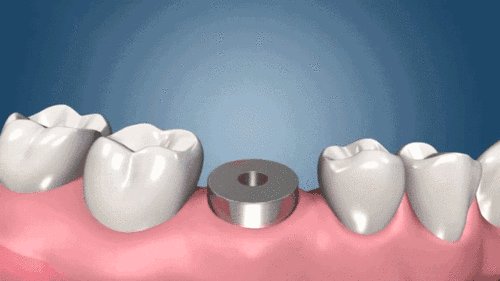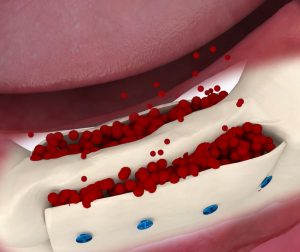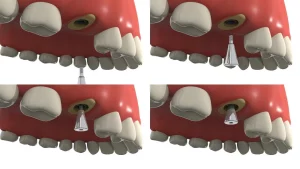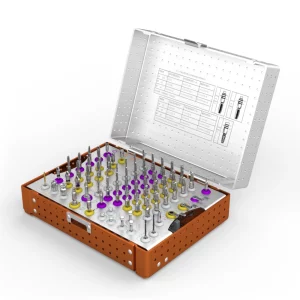Dental implants, as an effective and lasting solution for tooth restoration, have become widely used in modern dentistry. The success of dental implants depends not only on the stability and biocompatibility of the implant but also on the selection and placement of the healing abutment. The healing abutment, also known as a temporary abutment, is an important component after implant surgery. It serves to cover the implant and protect the surrounding soft tissues. This article will provide a detailed guide on how to choose the right healing abutment to ensure the success and stability of dental implants.

Functions of the Healing Abutment
- Promoting Healing: Healing abutments are usually made from temporary materials such as plastic or temporary ceramics, which have good biocompatibility. These materials provide an optimal healing environment for the surrounding tissues without bearing the forces of normal occlusion.
- Temporary Support and Protection: After the implant is placed, a period of osseointegration is required for the implant to fuse with the surrounding alveolar bone. The healing abutment provides temporary support and protection during this process, ensuring that the soft tissues around the implant heal properly.
- Guiding Gingival Shaping: The design of the healing abutment is typically flat, which helps guide the formation and regeneration of the gingival tissue, leading to the development of a well-formed gingival cuff. This structure lays a solid foundation for the installation of the final abutment and crown.
Factors to Consider When Choosing a Healing Abutment
Selecting the right healing abutment is a crucial step in ensuring the success of dental implants. The following are key factors to consider when choosing a healing abutment:
- Gum Thickness
- Thick Gum: If the patient has thick gums, a taller healing abutment may be necessary to ensure enough height above the gums, allowing the formation of a proper gingival cuff for future prosthetics.
- Thin Gum: For patients with thin gums, a shorter healing abutment should be selected to avoid excessive pressure on the gum tissue, which could lead to gum recession or damage.
- Implant Depth
The depth at which the implant is placed beneath the bone will affect the choice of healing abutment. If the implant is placed deeper, a longer healing abutment may be required to fully cover the implant and provide adequate support. Conversely, if the implant is placed more superficially, a shorter healing abutment should be chosen to avoid unnecessary interference with the surrounding tissues. - Tooth Position
The position of the tooth will dictate the size and shape of the healing abutment. For example, the anterior (front) teeth require a healing abutment that is aesthetically pleasing and contours well to the gum shape. The posterior (back) teeth, on the other hand, prioritize functionality and stability, so a more durable and sturdy healing abutment may be necessary. - Aesthetic and Functional Requirements
The choice of healing abutment should also depend on the patient’s aesthetic and functional needs. For patients who require the restoration of chewing function, the healing abutment should provide enough support and stability. For those concerned with aesthetic outcomes, a healing abutment that matches the natural appearance of teeth and gums should be selected.
Types of Healing Abutments
Healing abutments come in a variety of types based on their shape, material, and intended use. Below are some common types of healing abutments:
- Standard Healing Abutments
Standard healing abutments are the most commonly used type, suitable for the majority of dental implant surgeries. They come in standard sizes and shapes, making it easy to install them on the implant while providing adequate support and protection. - Customized Healing Abutments
Customized healing abutments are tailored to fit the specific needs and conditions of the patient. They can be precisely matched to the patient’s tooth and gum morphology, offering a better fit and more aesthetic restoration results. Customized healing abutments are typically used for anterior (front) tooth restorations to improve aesthetic outcomes. - Cap-shaped Healing Abutments
Cap-shaped healing abutments consist of two parts: a spherical structure fixed to the implant and a removable cap-like structure. This design allows the clinician to adjust the position and height of the abutment more flexibly during the surgical process, making it suitable for implants that require higher adaptability. Cap-shaped healing abutments are often used in implant surgeries that demand more flexibility. - Mucosal Level Healing Abutments
Mucosal level healing abutments are designed to sit flush with the surrounding gum tissue. This type of healing abutment minimizes irritation and damage to the gums, promoting better healing and regeneration of the gingival tissue. Mucosal level healing abutments are typically used for patients with thin gums or those needing improvement in gum morphology.
how long does healing abutment stay in
Healing abutments are generally left in the mouth for about 2-3 weeks, although the exact duration depends on the individual patient and their oral condition. In some cases, they may need to remain in place for about 3–6 months. The main role of the healing abutment in implant surgery is to ensure that the implant successfully integrates with the alveolar bone and to guide the gums into a normal shape.
After the healing abutment is placed on the implant, patients need to pay close attention to their oral hygiene, avoid consuming hard or irritating foods, and refrain from heavy biting to prevent disrupting the healing process. Additionally, patients should regularly visit the dentist for follow-up appointments and check-ups. Once the implant has successfully integrated with the bone, a permanent abutment is typically placed for long-term use.
Guide to Correct Selection and Placement of Healing Abutments
Selecting and placing the healing abutment is a crucial step in implant surgery. Here is a step-by-step guide on how to properly select and place a healing abutment:
1. Selecting the Healing Abutment
Consider Individual Factors:
When choosing a healing abutment, consider factors such as the patient’s tooth position, gingival thickness, depth of implant placement, and soft tissue height. For instance, patients with thicker gingiva may require a higher healing abutment to ensure sufficient exposure above the gums.
Determine the Abutment Size:
- Диаметр: The diameter should match the implant and future permanent abutment, with common sizes such as 4.0mm, 4.5mm, 5.5mm, and 6.5mm.
- Height: Typically, the implant is placed 0.5-1mm below the bone surface, and the gingiva thickness is usually 3-4mm. The healing abutment should extend 1-2mm above the gingiva, so a 5mm abutment is most commonly used. For deeper implants, a height of 7mm or more may be necessary.
Choose the Type of Abutment:
- Stock Abutments: Made by manufacturers based on the dentist’s specifications, stock abutments typically offer a good fit and require little modification.
- Custom Abutments: Suitable for local implants, these can be ground to match the spacing between the bone and gingiva.
- Personalized Abutments: When stock or ground abutments are not suitable due to the patient’s unique bone structure, a custom-made abutment is used to ensure better fit and higher success rates.
2. Steps for Placing the Healing Abutment
Pre-surgical Check and Preparation:
Before placing the healing abutment, use X-rays to confirm the implant’s stability and fit within the bone. Local anesthesia is applied, and a small incision is made in the gingiva over the implant to expose the cover screw.
Remove the Cover Screw:
Using a screwdriver, remove the cover screw and carefully clean any bone and soft tissue around the implant fixture.
Measure Gingival Thickness:
Measure the gingival thickness around the implant site to ensure the correct height of the healing abutment, typically leaving 1-2mm above the gingiva.
Place the Healing Abutment:
Position the selected healing abutment and tighten the central screw. Use a metal rod instrument to tap the abutment, producing a crisp metallic sound, indicating proper seating. An X-ray can be taken to verify the placement.
Suturing and Aftercare:
Suture the gingival incision and remove the sutures after one week. For the first 24 hours, avoid brushing or drinking water to prevent bleeding. Also, patients should maintain oral hygiene while avoiding hard or irritating foods that may affect the healing process.
3. Post-surgical Care and Follow-up
Regular Check-ups:
Follow your dentist’s recommendations for regular check-ups to ensure proper healing and implant success.
Maintain Oral Hygiene:
Brush your teeth regularly and use dental floss to keep the area clean. Oral hygiene is essential to prevent infection and ensure proper healing.
Dietary Considerations:
Avoid consuming hard, chewy, or spicy foods that may interfere with the healing of the implant and surrounding tissues.
In conclusion, selecting and placing a healing abutment requires a comprehensive understanding of the patient’s oral condition and a careful, step-by-step approach. Post-operative care and follow-up are essential for the success of dental implants. If there are any questions or discomfort, always consult with your dental professional for advice and assistance.
Frequently Asked Questions About Healing Abutment Selection
- What is the function of a healing abutment in dental implant surgery?
In dental implant surgery, a лечебный абатмент is a temporary component that protects the implant and promotes the healing of soft tissues (like the gums) around it. Additionally, it directs the development of gum tissue, laying the groundwork for the eventual permanent crown and abutment. - What aspects need to be taken into account when selecting a healing abutment?
The patient’s gingival thickness, tooth location, implant insertion depth, and cosmetic requirements should all be taken into account while choosing a healing abutment. - How can I determine the healing abutment’s size?
The diameter and height of the implant are usually matched by the size of the healing abutment. Common diameters are 4.0, 4.5, and 5.5 mm, and the height is typically chosen in accordance with the implant depth and gingival thickness. - What should be selected for patients who have thin gums?
A lower healing abutment is usually used for patients with thin gums in order to reduce gum pressure and avoid gum recession. - What should be selected for patients who have thick gums?
A higher healing abutment is often advised for patients with thick gums in order to provide enough height above the gums and aid in the formation of the perfect gingival cuff. - How is a healed abutment’s height established?
A healed abutment’s height is normally 1-2 mm above the gingival edge. The gingival thickness and implant depth are taken into consideration while choosing the height. - How does the healing abutment vary in the anterior and posterior regions?
A more elegant, precisely fitted, customized healing abutment is often used in the anterior area due to cosmetic concerns. A stronger, longer-lasting healing abutment is usually chosen for the posterior area, which is more function-focused. - How much time is typically spent in the mouth with a healing abutment?
Until the implant completely integrates with the jawbone, a healing abutment is usually retained in place for two to three weeks. Depending on the patient’s health, it could need to stay for three to six months. - Is a conventional healing abutment suitable for all patients?
Standard healing abutments are not appropriate for every patient. Patients with distinct gingival or bone characteristics could need a specially designed healing abutment. - How can I make sure the healing abutment is positioned properly?
Based on the patient’s unique requirements, the dentist will choose the right size and kind of healing abutment and make sure it is securely fastened. To guarantee appropriate recovery after surgery, the patient should adhere to oral hygiene guidelines and schedule routine follow-up appointments.





